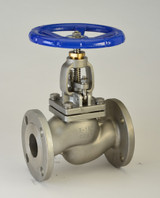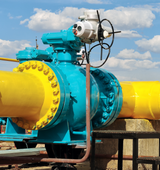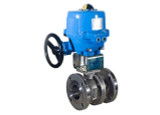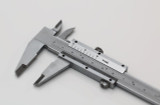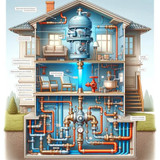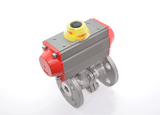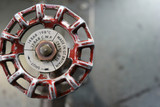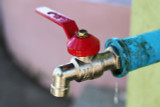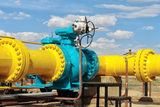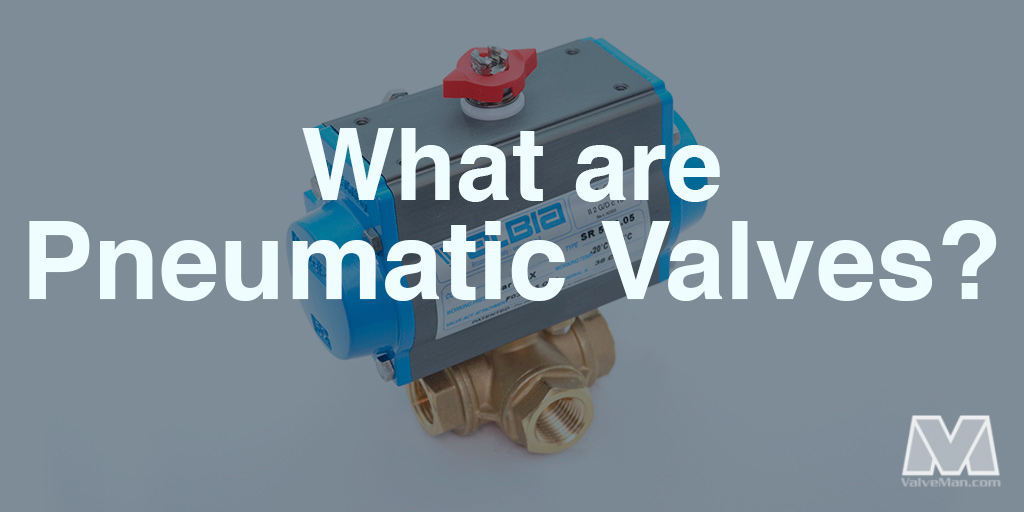
What is a Pneumatic Ball Valve?
A pneumatic ball valve is a quarter-turn valve operated by compressed air through a pneumatic actuator. Inside the body, a rotating ball with a port opens or blocks flow. These valves are widely used because they are compact, provide tight shutoff, and support efficient automation in piping systems.
They are available in multiple port configurations and can be mounted with either spring return or double acting actuators, depending on your application.
How Do Pneumatic Actuated Ball Valves Work?
Pneumatic valve systems use differences in air pressure to control media flow. Compressed air is stored in a reservoir or diaphragm, where it interacts with the surroundings when introduced by a compressor.
Upon reaching sufficient pressure, the compressed air compresses the underlying springs, forcing the diaphragm downwards. Consequently, the valve stem is activated, leading to the closure of the valve.
When the air is released from the diaphragm, the springs expand, causing the valve stem to rise and thereby opening the valve. This mechanism allows for precise pressure control and ensures the smooth operation of the machine.
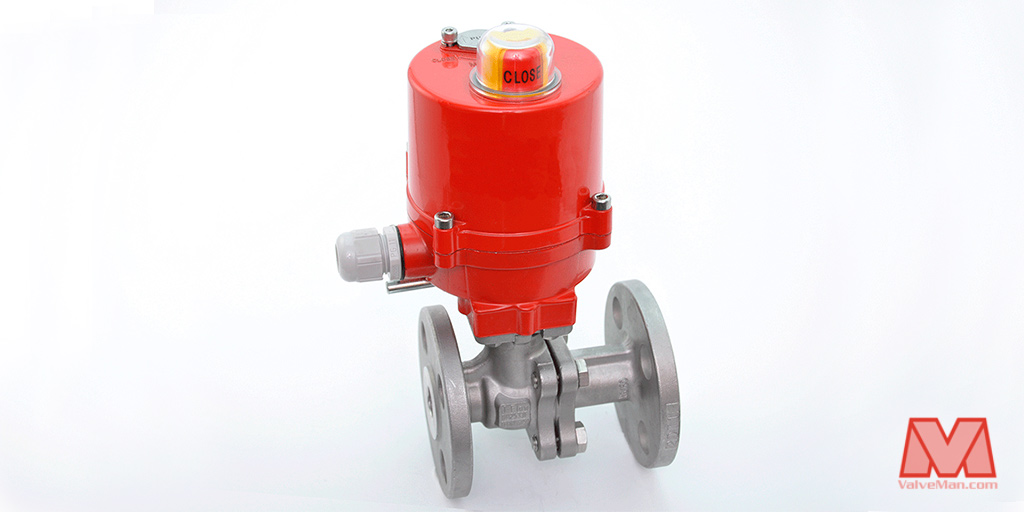
Simplified Flow Control With Automated Ball Valves
In modern industrial systems, automated ball valves play a critical role in reducing manual intervention and improving efficiency. By pairing a robust ball valve body with a pneumatic actuator, these assemblies deliver precise and repeatable control at the push of a button — or in many cases, entirely hands-free.
Automated ball valves offer several advantages:
- Eliminate the need for manual valve operation in high-cycle systems
- Provide reliable shutoff and flow control under demanding conditions
- Support both spring return and double acting actuator configurations
- Offer compact designs with a long service life to minimize maintenance
- Adapt to a wide range of pipe size and port requirements
For industries where uptime and efficiency are paramount, automated ball valves simplify complex flow control and ensure smooth integration with existing automation systems.
Common Applications of Pneumatic Valves
Pneumatic valves have several key applications, including the following:
- Industrial Automation: Pneumatic valves are extensively used in automated manufacturing processes to regulate pressure and actuate various mechanical components. They are commonly used in assembly lines, packaging equipment, and robotic systems.
- HVAC Systems: Pneumatic valves help the flow of air, ensuring optimal temperature regulation, air quality, and energy efficiency in commercial buildings, hospitals, and industrial facilities.
- Water and Wastewater Treatment: Pneumatic valves are utilized in water and wastewater treatment plants to manage the flow of water, chemicals, and other fluids during different stages of the treatment process. They help regulate the dosage of chemicals and control water flow.
- Oil and Gas Industry: Pneumatic valves are employed in oil and gas production facilities to control the flow of crude oil, natural gas, and various chemicals used in extraction, refining, and distribution processes.
- Food Processing: Pneumatic valves are commonly utilized in food processing plants to regulate the flow of ingredients, control mixing processes, and ensure hygiene and safety standards.
Available Materials and Sizes:
When it comes to selecting the right pneumatic valve for your application, considering the material, pressures, chemical compatibility, and size is crucial. Our company offers a wide range of pneumatic valves in different materials, including:
Our valves are available in different sizes to fit specific system requirements, ensuring compatibility and optimal performance. We offer the following pneumatic valve sizes:
Why Choose ValveMan?
- Wide selection of pneumatic ball valves and accessories
- Industry-tested products with long service life
- Options for spring return and double acting actuators
- Multiple pipe size and port configurations available
- Easy navigation—click through our catalog to find the right solution quickly
What Are the Advantages of Pneumatic Valves?
Pneumatic valves utilize air actuation, offering numerous advantages that make them an excellent choice for industries worldwide. Some of the key benefits include:
- Quick Response Time: Pneumatic valves provide rapid response and high-speed actuation, allowing for precise control in time-sensitive applications. They can quickly open or close, enabling efficient regulation of fluid flow.
- Reliability: Pneumatic valves are known for their durability and long service life, even in harsh operating conditions. They can withstand high pressures, temperature variations, and exposure to various chemicals.
- Safety: Pneumatic valves are inherently safe to use as they do not generate sparks or create fire hazards. This makes them ideal for applications in potentially explosive environments, such as oil and gas industry operations.
- Efficiency: Pneumatic valves consume minimal energy during operation, resulting in cost savings and environmental benefits. They contribute to energy-efficient processes and reduce overall operating costs.
- Versatility: Pneumatic valves can be easily integrated into existing systems and adapted to different control requirements. They offer flexibility and versatility, allowing for efficient customization based on specific application needs.
To take advantage of the numerous benefits of pneumatic valves, find reliable and top-quality valve providers, such as ValveMan. Contact us today to learn more about how we can help you or request a quote for your tailored valve project.
Frequently Asked Questions
Can pneumatic valves be used for both high and low-pressure applications?
Yes, pneumatic valves can be designed to operate within a wide range of pressures, making them suitable for both high and low-pressure applications. The valve selection should be based on the specific pressure requirements of the system.
Are pneumatic valves suitable for controlling corrosive substances?
Yes, pneumatic valves can be manufactured from materials that are resistant to corrosion, ensuring reliable performance when handling corrosive substances. Stainless steel or specialized coatings are commonly used to protect the valves from chemical damage. There are even stainless steel actuators available for highly corrosive environments such as salty air areas or plants that use caustic washdown protocols.
Are pneumatic valves automated?
Yes, pneumatic valves are automated valves. That is what makes them so efficient and accurate, offering enhanced system control compared to non-automated valves.
Do pneumatic valves require regular maintenance?
While pneumatic valves are known for their durability, routine maintenance is essential to ensure optimal performance and prolong their service life. Regular inspections, cleaning, and lubrication are recommended.
Are air operated ball valves and pneumatic ball valves the same thing?
Yes. “Air operated ball valves,” “air actuated valves,” and “actuated ball valves” are all interchangeable terms for pneumatic ball valves.
Can I use a ball valve for compressed air?
Yes. Pneumatic ball valves are specifically designed to handle compressed air safely and efficiently.
What is the difference between 5/2 and 5/3 pneumatic valves?
A 5/2 valve has five ports and two positions, while a 5/3 valve has five ports and three positions, allowing for additional control states.
How does a pneumatic actuated valve work?
Compressed air moves a piston in the actuator, which rotates the ball inside the valve body to open or close flow.
What is the difference between a ball valve and an actuated valve?
A ball valve is a manually operated device, while an actuated valve integrates an actuator (pneumatic, electric, or hydraulic) for automation.
Pneumatic Valves - Related Articles
Practical Guide To Electric and Pneumatic Actuators – Which One To Choose?
Using an Actuated Ball Valve Or a Solenoid Valve For Best Fluid Control In The System
What does a double acting actuator do?
What are the types of solenoid valves?
Why Choose a Namur Solenoid Valve for a Pneumatic Actuator
Why Choose ASCO Solenoid Valves?
Our Posts
View AllGlobe Valve vs Ball Valve Comparison Guide | ValveMan
Valves are widely used in industrial and manufacturing facilities, but they’re also used in utilitie …
Read MoreNEMA Ratings Explained | ValveMan
Have you ever wondered what that little NEMA number on your electric actuator meant? Or perhaps, you …
Read MoreGate Valve vs Ball Valve Comparison Guide | ValveMan
Valves are widely used in industrial and manufacturing facilities, but they’re also used in utilitie …
Read MoreValve Inspection - Main Points of Valve Inspection and Testing in Manufacturing Settings
Industrial facilities rely on different types of valves (such as gate valves, check valves and ball …
Read MoreCan Ball Valves Be Used For Flow Control?
Ball valves are widely used in plumbing and piping systems, in fact, they are one of the most common …
Read MoreIntroducing Bonomi Valves
The Bonomi Group is a leader in industrial sectors including oil and gas, hydraulics, heating and en …
Read MoreUnderstanding Valve Actuators: Manual, Electric, Pneumatic and Hydraulic
Are you a beginner new to the valve world, ready to learn more about the various types of valve actu …
Read More3 Check Valve Mistakes to Avoid
So, you’re looking for a check valve, but you’re not sure if there’s any pitfalls to look out for? O …
Read MoreTypes of Valves in Plumbing
Have you ever wondered what goes into managing the flow of water in your home, or through a building …
Read MoreIntroducing Apollo Valves
Apollo Valves® inventory includes a wide range of valve products supplied to diverse markets. These …
Read MoreUnderstanding Valve Sizes and Measurement
Sizing the appropriate valve is critical to ensuring the performance of your system. Whether you'r …
Read MoreTypes of Water Valves
Hey there, fellow valve enthusiasts! We all know that valves play a crucial role in regulating th …
Read MoreWhat is a Backflow Preventer, and How Does it Work?
When a simple check valve is inadequate for the job, you need a backflow preventer. But knowing …
Read MoreTypes of Ball Valves
Ball valves are important components in a vast range of systems, from small family-owned workshops …
Read MoreUnderstanding valve standards and specifications
Hey there, fellow valve enthusiasts! Today, we're looking at valve codes, standards and specifica …
Read MoreHow to Tell if a Valve is On or Off
We have all been there before. You are staring at a valve; you know that you should know if it …
Read MoreUnderstanding Different Types of Valve Connections and Fittings
Hey there, fellow valve enthusiasts! We know valves play a crucial role in regulating the flow of li …
Read MoreTypes of Valve Handles: Lever and Handwheels
Whether you're involved in industrial work, plumbing, or you're a DIY enthusiast, you come across …
Read MoreThe Basic Parts of a Valve
Valves quietly work in many different areas, even places you wouldn't expect. They're truly every …
Read MoreGas Ball Valves In Industrial Applications - 5 Things to Keep in Mind
Unlike the standard ball valves, most gas ball valves are tested and approved by CSA. These valves a …
Read More
